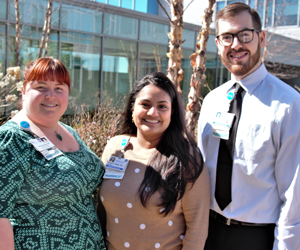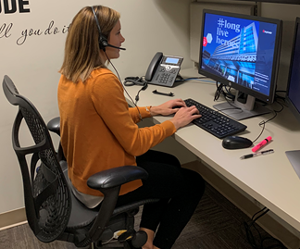 Patient-Centered Care
Patient-Centered Care
Sub-Domain: Practice-Focused
A Pharmacist-led Oral Chemotherapy Medication Therapy Disease Management Clinic
Submitted by Tristan Maiers, Pharm.D., BCOP, Anupama Mathur, Pharm.D., BCOP,
Justine Maley, Pharm.D., Annie McDermott, Pharm.D., BCOP, Jenna Carmichael, Pharm.D.
 Case Overview
Case Overview
We created a pharmacist-led oral chemotherapy medication therapy disease management (MTDM) clinic to meet the needs of Geisinger patients. The service line covers all patients on an oral chemotherapy agent throughout the entire health system through a telephone-based model.
Three full-time pharmacists and one full-time pharmacy technician equivalents are utilized per day. As of October 1st, 2020, the clinic follows approximately 1,100 patients, resulting in, on average, 80-90 encounters per day. Notes are completed in the patient’s medical record and shared with the patient’s hematologist/oncologist.
Through a collaborative practice agreement, the pharmacist can prescribe chemotherapy refills, prescribe supportive care medications, and order therapy-related laboratory monitoring. The program offers several services including medication education, symptom management, lab ordering and monitoring, medication dose adjustments, and review of drug interactions.
The pharmacists serve as a key reference and resource to the oncology providers for various chemotherapy questions. In addition to oral chemotherapy, the team also manages immunotherapy-related adverse effects, as well as benign hematologic conditions such as idiopathic thrombocytopenic purpura and autoimmune hemolytic anemia. All of these services are offered separately from the Geisinger-affiliated specialty pharmacy, which dispenses the oral chemotherapy as able.
In addition to many patient-centered services, the clinic is also a learning environment for Advanced Pharmacy Practice Experience students and post-graduate year 1 and 2 (PGY1 and PGY2) residents.
 Key Elements
Key Elements
Our first key element of success is having enough personnel resources to meet the increasing patient population and the respective therapy needs. The clinic has grown over time with additional pharmacist full-time equivalents (FTEs) and the addition of a pharmacy technician as the workload increased. The pharmacy technician has taken responsibility for triaging incoming patient calls to the clinic, scheduling patient encounters, contacting stable patients regarding laboratory results after pharmacist review, and following up with specialty pharmacies regarding medication access. This has allowed the pharmacists to be more accessible to providers and patients with acute issues related to their oral chemotherapy.
Provider buy-in for our services has been an essential aspect of sustaining and expanding our clinic. As the number of patients on oral chemotherapy increased, our providers noted a clear distinction between patients that would benefit from in-person office visits and those that could be managed telephonically through our clinic. As such, the Cancer Institute is funding the pharmacist FTEs for the oral chemotherapy clinic, enabling pharmacists to be physician extenders to better serve our patient population. The pharmacy technician FTE is supported by the oncology pharmacy department in order to offset administrative tasks and increase the availability of pharmacists for clinical questions and issues.
Lastly, our technology platform allows for more efficient patient interactions. The clinic utilizes telephone appointments, which allow the patient to take our calls in the comfort of their own home or return our calls at their convenience. Patients can have their medications in front of them when discussing issues with the pharmacist. In addition, patients can have labs done locally at a Geisinger facility or outside the laboratory and the clinic will receive the results. Many patients find this to be convenient, given the health system’s outreach area. The telephonic services that the Oral Chemotherapy Clinic provides became increasingly crucial through the COVID-19 pandemic, as bringing high-risk patients for in-person visits was not favorable. Many providers sought our assistance in following up with patients via telephone to reduce routine clinic visits that could be deferred to a later time.
Impact on Patient Outcomes
Our oncology physicians have commented on the improved patient support provided by the pharmacist as a result of close monitoring and side effect management. A physician feedback survey revealed that by using pharmacists as physician extenders, the amount of clinic time for routine follow-ups decreased, allowing them to see more critical patients with greater needs.
Their continued support for the services provided by our clinic is evidenced by increased funding for pharmacist FTEs.
In addition to our physician colleges seeing the real-world impact of our patient interventions, our patients verbalize their gratitude for our services and utilize us whenever possible. It is not uncommon for patients to contact our clinic first for medication-related issues before attempting to speak to their oncologist.
Pharmacy and Pharmacist Roles
Pharmacists in the oral chemotherapy clinic are integrated into the medical team as mid-level providers. The clinic maintains a daily schedule within the electronic health record (EHR) that all three pharmacists share. Patients are placed into appropriate time slots based on region of their managing hematologist or oncologist, and whether they are a new referral, need chemotherapy education, need follow up for lab results, or are due for a toxicity assessment. When a new referral is received to follow a patient on oral chemotherapy, the pharmacists conduct a review of the patient’s disease and therapeutic history, review baseline laboratory results and tests, and ensure that the correct dose has been prescribed based on the indication.
We work closely with specialty pharmacies to expedite drug delivery to the patient. In some cases, we also work with insurance companies to provide information necessary for prior authorizations and appeals. Once a patient receives the medication, the pharmacist will perform thorough medication counseling, including: medication reconciliation and drug interaction review, how to take the medication, what to expect from the medication, handling and storage precautions, and discuss frequency of follow up and lab monitoring.
After the initial encounter, patients are called weekly for the first month of therapy and subsequent follow up thereafter varies based on adverse effects and recommended lab monitoring. Many of our patients receive a follow-up phone call at least once a month from the Oral Chemotherapy Clinic.
Lessons Learned
Measure the value of care provided in order to sustain and show value for a pharmacy-based service. This is especially true in a clinic such as ours, where our value is demonstrated through cost avoidance rather than billable visits. Create methods to track pharmacist interventions from the EHR. Examples of this include flowsheet documentation and smart data elements within written documentation that can be translated into discrete data points.
Prioritize what services should be conducted by your pharmacy team. With limited resources, it is important to choose tasks that add value to the patients you serve. If your services expand rapidly, it may be challenging to manage the workload and triage patients efficiently. For example, we started monitoring laboratory values and conducting symptom reviews on all patients treated with immune checkpoint inhibitors. The number of patients increased so quickly that we had to scale back and only follow patients with active toxicities and those on steroid tapers to manage treatment-related side effects. This allowed us to provide the highest value care, without exceeding pharmacist workload capacity.
Integrate resident learners to facilitate service line expansion. Over the last year, we had several requests from providers for increased pharmacy support; however, it was challenging to implement new services with our current workload. One example of this was in the neuro-oncology multidisciplinary clinic, where patient volumes have increased significantly. By integrating a PGY2 resident into the practice site, we were able to conduct a successful pilot study to determine roles for the pharmacist in this particular setting, as well as best practices and optimal time utilization for all providers involved. This pilot study ultimately led to the approval of a pharmacist FTE for the neuro-oncology clinic.
Budget & Resource Allocation
The pharmacist FTEs are paid for by the Geisinger Cancer Institute. The pharmacy technician FTE is provided in our oncology pharmacy budget.
The clinic grew over time with pharmacist and clinic assistant staff as the workload increased. The clinic assistant has taken over much of the incoming patient calls, which allows the pharmacist to handle provider questions or perform outgoing telephone encounters. What started as a one pharmacist clinic, has grown into a team of three pharmacists and one pharmacy technician.
Future Goals
Our health system uses Epic for the EHR and the Beacon oncology module. Infusional chemotherapy plans have been a mainstay of practice for several years, and we are currently expanding this by developing oral chemotherapy plans within Beacon as well. Similar to infusional chemotherapy plans in Beacon, the oral chemotherapy plans will also contain important treatment alerts, standardized dosing when possible, and necessary lab orders. The pharmacists in the clinic will also be responsible for reviewing the appropriateness of oral chemotherapy prescriptions prior to being sent to a specialty pharmacy. Additional benefits anticipated include documentation of cycles and dates, dose adjustments, and treatment delays within Beacon, allowing such information to be easily identifiable in one location within the EHR.
As a growing service, we continually strive to demonstrate our value to patients, physicians, and our pharmacy colleagues. We recently incorporated the use of smart data elements within Epic to collect data regarding pharmacist interventions in our clinic. The team is in process of analyzing data from our newly formed pharmacy dashboards to showcase where our pharmacists have the greatest impact on patient care. We are also developing tools to evaluate patient perceptions and satisfaction with our services.
